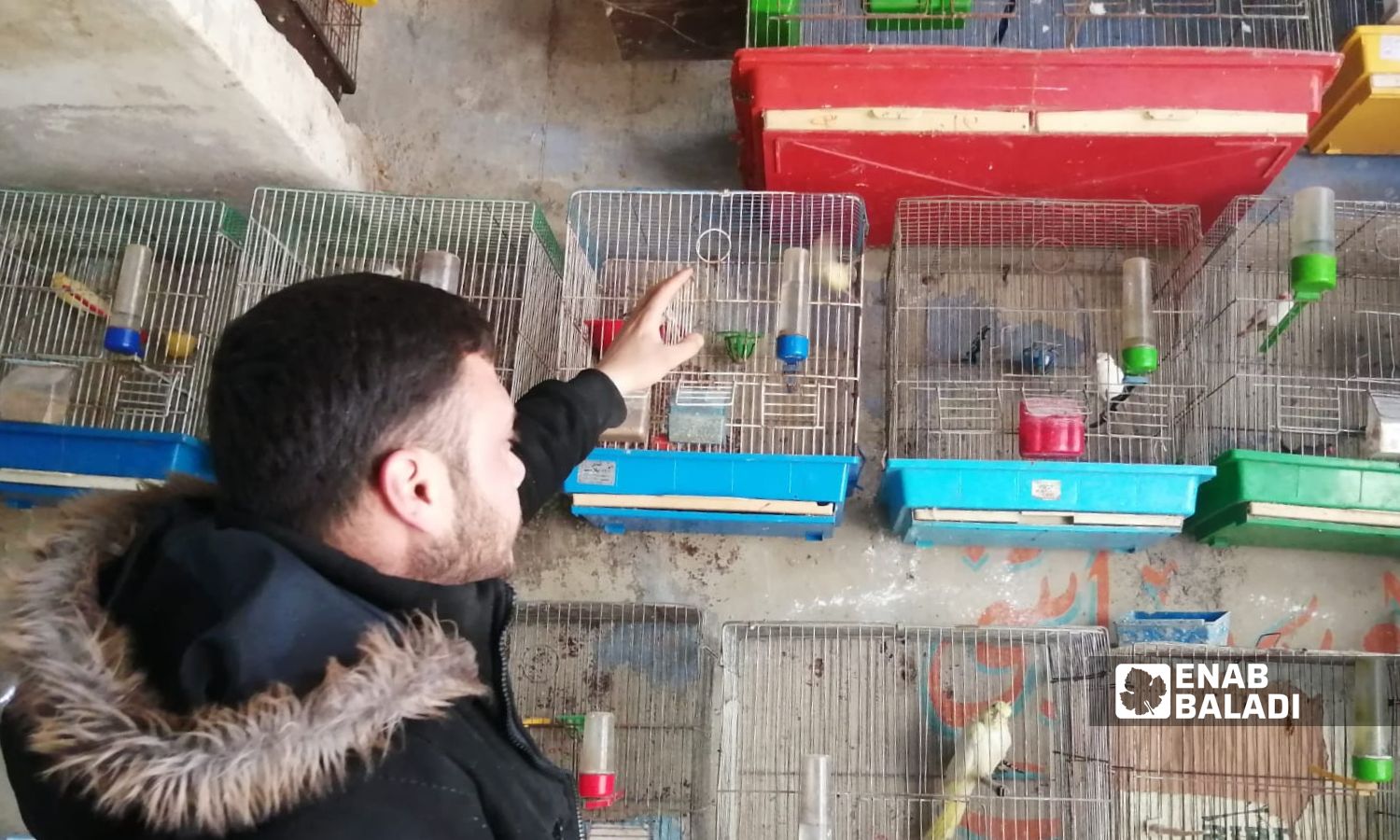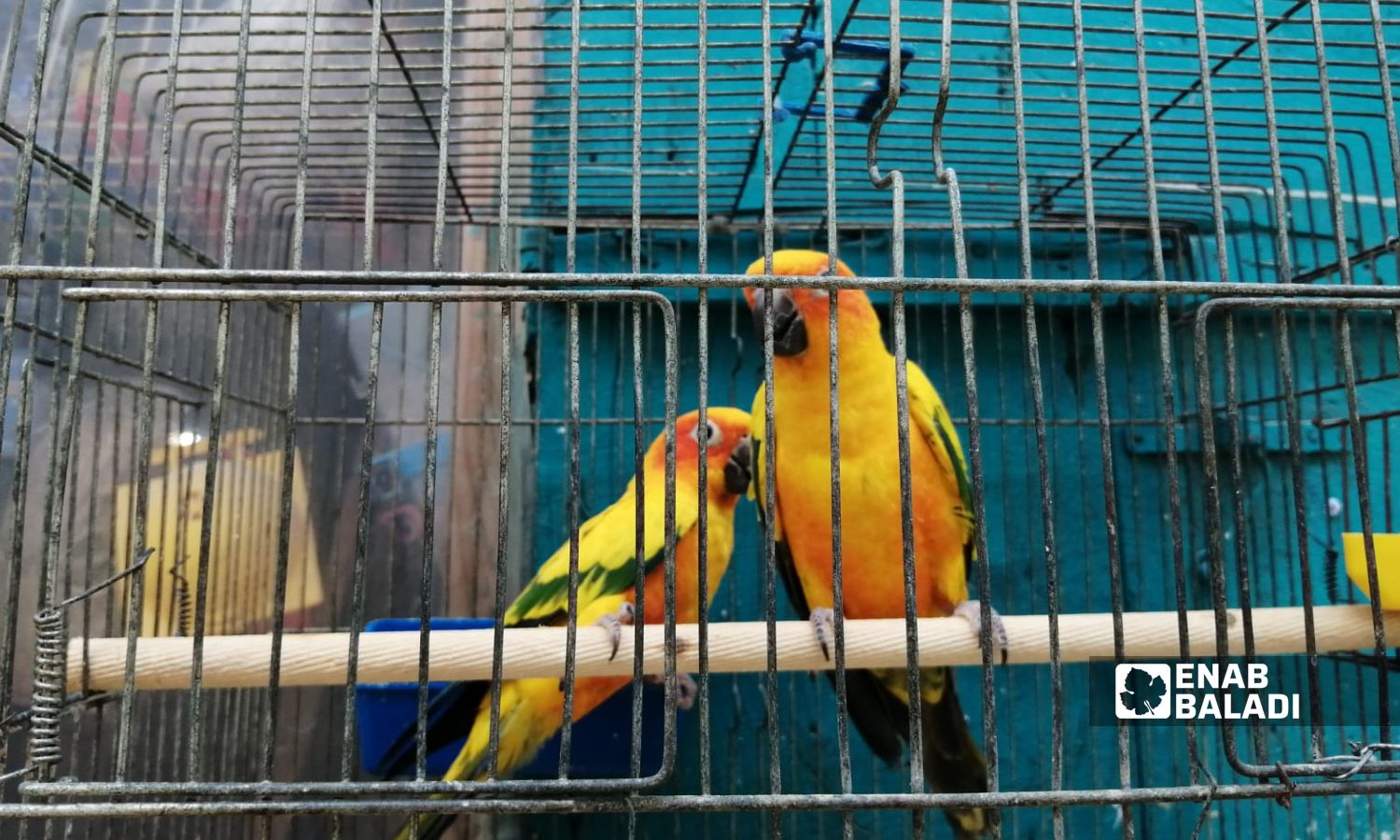



In his small shop in the ancient Kafr Takharim market in northern Idlib, sits young Mahmoud Nureddin (27 years old) on a wooden chair, watching a cage with a pair of brightly colored parrots nibbling on sunflower seeds and emitting harmonious sounds like a sweet symphony.
In the young man’s shop, there are neatly arranged iron cages housing various species of birds, where they display a variety of colors and forms and range in size from medium to small.
“This is an imported parrot called a Sun Conure, and it has not laid eggs yet. It is also unfamiliar in our region, but I believe it will be a good breed,” said Nureddin, referring to the cage he was observing.
Nureddin managed to turn his passion for birds from a hobby he cherished since childhood into a profession when he opened his shop a few years ago, and it became his only source of livelihood after he left his job as a tile setter.
Nureddin told Enab Baladi that breeding birds requires patience and “long breath” as well as continuous care, making a comparison to small children who are affected by weather conditions and diseases due to their weak immune systems, especially the younger ones.
A moderately warm environment is suitable for breeding birds, as they get used to the place where they hatch “if it is cold they will need warmth constantly, and if it is hot they will need cooling—hence moderation is preferred,” according to Nureddin.

Birds displayed for sale inside a shop in the ancient Kafr Takharim market in rural Idlib – February 24, 2024 (Enab Baladi/Shams al-Din Matoun)
While Sulaiman al-Abdullah (39 years old), displaced from Aleppo and now living in rural Idlib, works as a barber, the corners of his shop are filled with boxes of ornamental birds of various shapes.
Al-Abdullah told Enab Baladi that the long hours he spends in his shop, especially during periods of few customers, pushed him to acquire several species of canary birds and look after them throughout the year until they lay their eggs and he raises their young with the intention of selling them.
This small trade provided al-Abdullah with additional income, relying on his barbershop customers to promote the birds he breeds, which attract some of the shop visitors to purchase due to their melodies and vibrant colors.
Birds require specialized food, water, and a bit of warmth to live in good condition and reproduce. The price of a kilo of food does not exceed one US dollar (31 Turkish lira), while the birds with long beaks eat sunflower seeds and others, and a boiled egg meal is provided for the female bird after laying its eggs, and for the young birds that need extra food to grow well.
Bird breeders can identify most diseases that affect birds by observing their movement, the shapes of their bellies, and the type of changes that occur. One of the most common diseases affecting birds is hepatitis, especially in recent years, with the increase in imported birds contributing to the spread of infection.
A sick bird can be treated with specific medication in the early days of its illness to help it recover quickly. However, if treatment is delayed, the effectiveness of the medication decreases, as does the bird’s bodily response, and it may die, according to Nureddin and al-Abdullah.

Birds displayed for sale inside a shop in the ancient Kafr Takharim market in rural Idlib – February 24, 2024 (Enab Baladi/Shams al-Din Matoun)
The lifespan of ornamental birds in most of their types ranges between three and ten years if they live in suitable conditions.
Mohammad al-Shater (32 years old) from Idlib city enjoys acquiring birds, especially canaries, as he hangs their cages on the door of the blacksmith shop where he works. He told Enab Baladi that he never considered bird trading but loves to see them for ornament only, preferring canary because it is distinguished by its voice and the various tones it emits.
“Whenever I feel the birds have grown and their movement has decreased, I replace them with more lively birds,” added al-Shater.
On the other hand, Mazen al-Shami, displaced from the countryside of Damascus, purchases newly born birds to take care of until they are able to mate, then offers them for sale to make a good profit.
Al-Shami keeps the birds in one room of his house, where he continually cares for them, considering them a part of his family, spending hours of his day beside them, and ensuring they have darkness at night to get their necessary sleep and rest.
The types of birds vary according to their colors and breeds; there are the local (known in the area) and the imported ones, which come with higher prices.
The price of a pair of Cockatiel parrot (male and female) starts from 50 US dollars to 150 dollars, while the price of the albino budgie ranges from 7 to 10 dollars for a pair, and the price of a Sun Conure parrot is 350 dollars, and local canary is priced between 15 and 50 dollars, while the imported starts from 50 to 150 dollars. Lovebirds, which are the most widespread species, do not exceed 10 dollars for a pair.
The prices of birds vary according to their varieties and how widespread they are. The melodies they produce are factors in determining their price, and whether they can talk or not like parrots and cockatiels. The prices of similar varieties differ according to their size, color, and readiness for egg-laying.
Cockatiel parrots need from 8 to 12 months to become capable of laying eggs, while canaries require eight months, and lovebirds need five months. The duration for which the female stays on the eggs until they hatch and young birds are born is from 18 to 24 days for most bird species.
if you think the article contain wrong information or you have additional details Send Correction